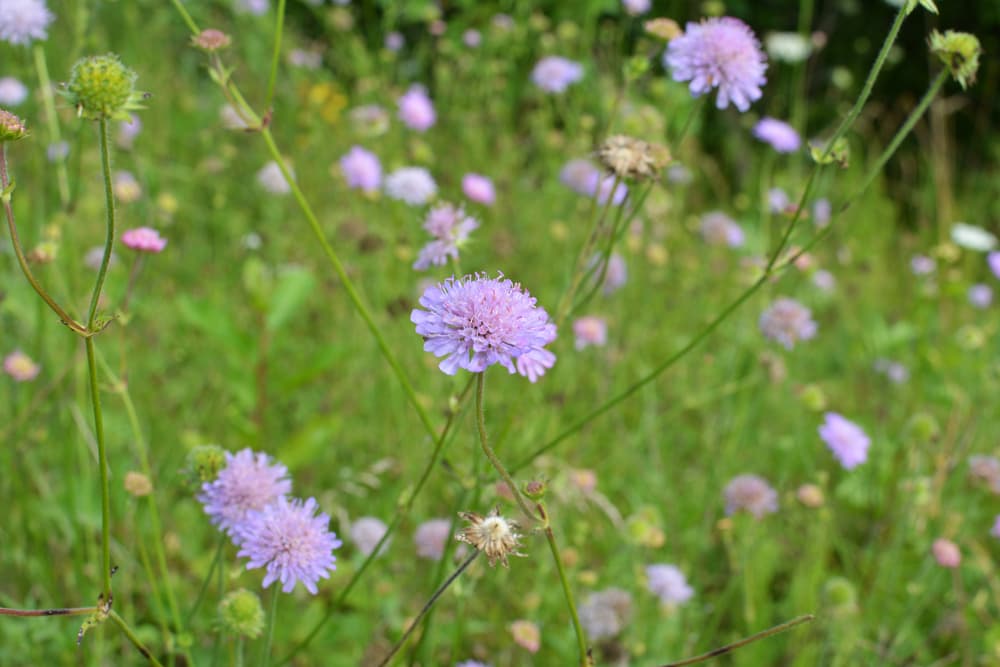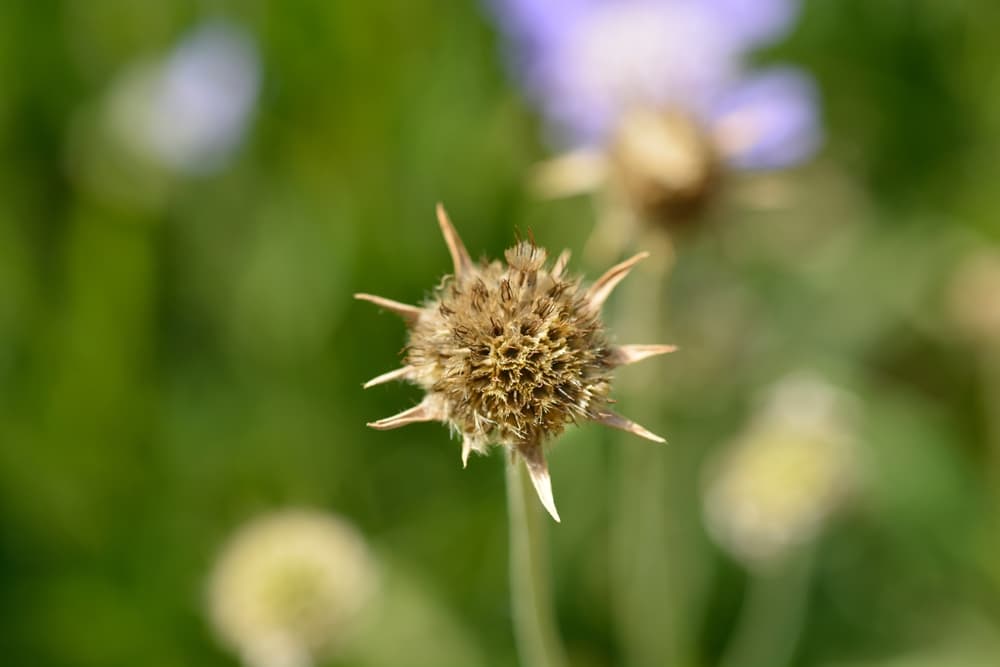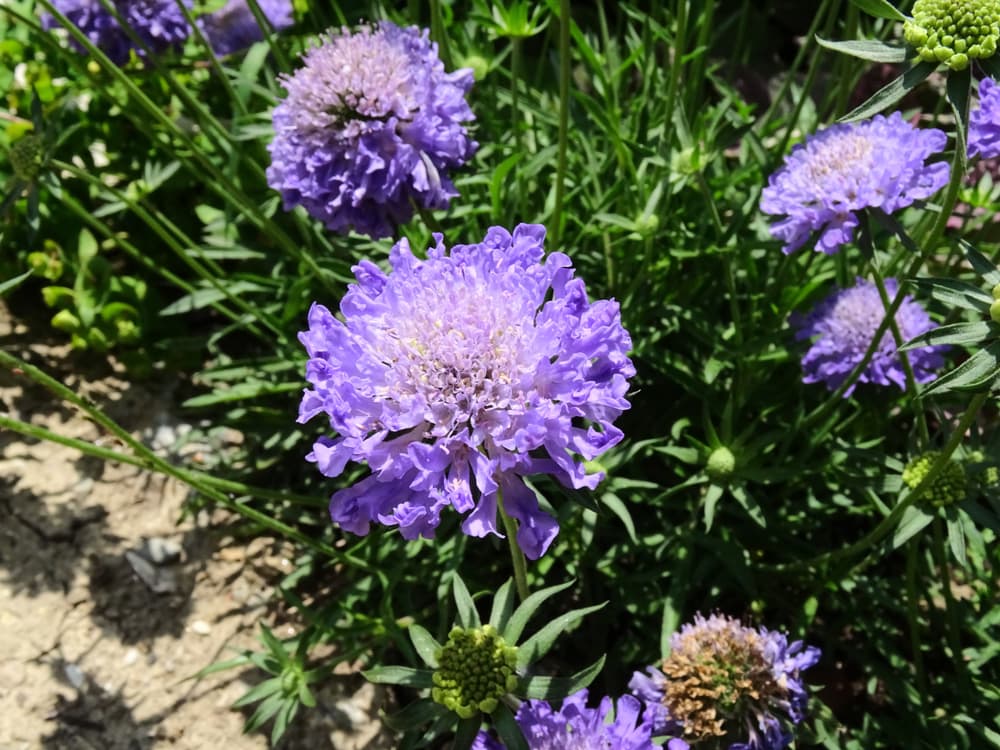Growing Scabiosa (Pincushions) – ‘Use Them In Many Ways And Across Many Garden Styles’

PERENNIALS > SCABIOSA
Reviewed By COLIN SKELLY

Colin is a Horticulturist and Horticultural Consultant with experience in a range of practical and managerial roles across heritage, commercial and public horticulture. He holds the Royal Horticultural Society’s Master of Horticulture award and has a particular interest in horticultural ecology and naturalistic planting for habitat and climate resilience.
IN THIS GUIDE
SCABIOSA GUIDES
Rich in colours, profuse in blooms, low in maintenance, and charming in appearance – that’s the Scabiosa plant for you.
As for said charming appearance, it is the result of the structure of the flower’s receptacle, florets, and stamens, which make it resemble a pincushion!
What do you call a flowering plant whose blooms have such different and varying forms, shapes, and petal arrangements that you would need over a score of descriptions for them?
You can call it Scabiosa. Or, to add to the confusion: Scabious, Knautia, and Pincushion Flower!
Adding even further dimension to the plant is the diverse array of colours the flowers come in, ranging from white to near-black, and in tones pastel through brilliant to saturated.
Overview
| Botanical Name | Scabiosa |
| Common Name(s) | Scabious, Pincushion Flowers |
| Plant Type | Perennial / Annual / Biennial Flower |
| Native Area | Africa, Europe & Asia |
| Hardiness Rating | H4 |
| Foliage | Deciduous |
| Flowers | Pincushion flower heads with enlarged outer florets |
| When To Sow | March, April, May, June, July, August, September, October |
| Flowering Months | June, July, August |
Sunlight
Preferred
Full Sun
Exposure
Exposed or Sheltered
Size
Height
0.1 – 0.5M
Spread
0.1 – 0.5M
Bloom Time
July – September
Soil
Preferred
Chalk, loam, sand
Moisture
Well drained
pH
Any
Scabiosa species come in both annual and perennial types, with even a few biennials squeezed in between.
As such, there’s a Scabiosa variety to suit every taste and every garden, from among its 68 species (which are typically under-counted) and about 240 hybrids and cultivars (not counting synonyms).1Scabiosa. (n.d.). Kew Royal Botanic Gardens. Retrieved March 24, 2023, from https://powo.science.kew.org/taxon/urn:lsid:ipni.org:names:14326-1
The Scabiosa genus is a member of the Honeysuckle Family.2The Editors of Encyclopaedia Britannica. (1998j, July 20). Scabious | Description & Major Species. Encyclopedia Britannica. Retrieved March 24, 2023, from https://www.britannica.com/plant/scabious

Its species are native throughout the Temperate and Sub-Tropical zones of Europe, Asia, and Africa.3Scabiosa. (n.d.-b). Plants for a Future. Retrieved March 24, 2023, from https://pfaf.org/user/Plant.aspx?LatinName=Scabiosa+columbaria
They do not grow in Tropical zones except for a few countries in Central Africa but some species, e.g. Centaurea scabiosa subsp. scabiosa, grow in even the Polar and Sub-Polar zones of Northern Russia, including Siberia.
The heaviest concentration of Scabiosa varieties is found in Mediterranean lands.
Naming Confusion
As for the various names for this plant, they are not exactly synonymous.
There is some overlap, disagreement, and – that word again – confusion as to which name applies to which plants or which genus.
Scabious used to be the common name for a set of loosely-identified flowering plants, and was – and still is – used interchangeably with the proper genus name, Scabiosa.

However, the common and non-technical name ‘Scabious’ actually identifies a subset of plants from Genus Scabiosa, and a subset of plants from related Genus Knautia.
And what about ‘Pincushion Flower’? Pincushion is a purely visually descriptive name that identifies many varieties of both Scabiosa and Knautia.
The reason is that several varieties have a rounded, clearly convex, receptacle from which numerous and prominent stamens protrude, bringing to mind a pincushion.

One can only hope that this little exposition reduces the confusion and certainly does not add to it!
Where there cannot be any confusion is in what these easy-going plants would bring to your garden: gaiety, butterflies, that little bit of ‘something different’ and a riotous medley of colours all through summer and even into early autumn.
Hardiness
The great diversity in Scabiosa species’ habitats means, quite naturally, that they are adapted to different climate zones.
Columbaria varieties usually are hardy from USDA zones 3 to 8 (RHS H5-H7) and Atropurpurea varieties from 4 to 11 (RHS H1C-H7).
Caucasica varieties are native to a very wide range and this is reflected in their hardiness zones from 2 through 9 (RHS H3-H7).
How To Grow Scabiosa
In general, you can let Scabiosa ‘run free’ in your garden with other wildflowers for an Alpine Meadow effect.
Then can be grown densely in beds or in ‘single file’ for colourful edging of walkways.
“There are species with smaller flowers and cultivars with large flowers, taller and shorter species and cultivars,” shares Horticultural Consultant Colin Skelly.
“This means that Scabiosa can be used in many ways and across many styles in the garden. I prefer to use them in meadow-style planting where their loose floral habit lends itself to the aesthetic.”

They are also wonderful companion plants to set off other plants and flowers that would be focal points.
However, the varieties are sufficiently different to call for very different treatments.
For example, S. graminifolia would be pefect for a rear patch of your garden or lawn, whereas S. caucasica ‘Fama White’ could be used as clumping companion plants to set off a focal point, be it a rose bush or stargazers, and S. atropurpurea ‘Fire King’ could be given a small flower bed of its own or grown in pots on a balcony.
No matter where you plant Scabiosa, they should be placed in very well-drained soil and get full sun.
All Scabiosa species should be grown in early to mid-spring though the perennials can be started in early autumn too.

As annuals, S. atropurpurea are grown by seed. S. columbaria varieties are usually propagated from basal cuttings and by plant division.
S. caucasica varieties are grown by seed as well as from basal cuttings besides which they are also propagated by division.
Pincushion Plant Care
As extraordinarily low-maintenance plants, you do not really need to care, as such, for them.
All you need to do to keep them happy is guard against some no-nos.
First, they have a strong preference for full sun.
Humidity and dampness play a large part in how well Scabiosa thrive – they do not prefer very wet or humid climates.

Moderate or low rainfall and dry weather suits these plants very well.
In general you can’t go wrong with chalky, loamy soils that have a neutral pH tending to alkaline. Soil must be well drained.
Scabiosa like rich soils but cannot tolerate heavy soils or clay soils.
Soil that retains dampness will cause the plant to start rotting – these plants are averse to shade and high humidity.
Pruning
As with virtually everything to do with this carefree plant, pruning is a simple affair.
Withered blooms should be deadheaded; this will keep the flowers coming.
If a perennial variety has become overly bushy or lop-sided, you may prune it by cutting directly above a limited number of leaf stalks.
Such species may also be cut back in the autumn.
Common Problems
These remarkable plants are among the most disease-free and pest-resistant.
This is another, and very important, reason that they are so low-maintenance.
Only some species may succumb on occasion to powdery mildew.
References
- 1Scabiosa. (n.d.). Kew Royal Botanic Gardens. Retrieved March 24, 2023, from https://powo.science.kew.org/taxon/urn:lsid:ipni.org:names:14326-1
- 2The Editors of Encyclopaedia Britannica. (1998j, July 20). Scabious | Description & Major Species. Encyclopedia Britannica. Retrieved March 24, 2023, from https://www.britannica.com/plant/scabious
- 3Scabiosa. (n.d.-b). Plants for a Future. Retrieved March 24, 2023, from https://pfaf.org/user/Plant.aspx?LatinName=Scabiosa+columbaria

